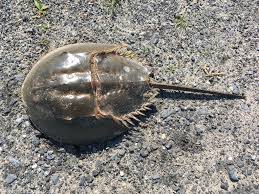Limulus – ZOOLOGY Notes – For W.B.C.S. Examination.
লিমুলাস – প্রাণী বিদ্যা নোট – WBCS পরীক্ষা।
A new horseshoe crab species, Limulus darwini, is described from the uppermost Jurassic (ca. 148 Ma) near-shore sediments of the Kcynia Formation, central Poland. The only extant species Limulus polyphemus (Linnaeus) inhabits brackish-marine, shallow water environments of the east coast of the United States. Here it is shown that there are no important morphological differences between the Kcynia Formation specimens and extant juvenile representatives of the genus Limulus. The palaeoecological setting inhabited by the new species and the trophic relationships of extant horseshoe crabs are discussed in an attempt to determine the potential range of food items ingested by these Mesozoic xiphosurans. In this paper we propose the adoption of a new term stabilomorphism, this being: an effect of a specific formula of adaptative strategy among organisms whose taxonomic status does not exceed genus-level. A high effectiveness of adaptation significantly reduces the need for differentiated phenotypic variants in response to environmental changes and provides for long-term evolutionary success.Continue Reading Limulus – W.B.C.S. Notes – For W.B.C.S. Examination.
Limulus polyphemus (Linnaeus, 1758), commonly known as horseshoe “crabs” and Limulus albus (Bosc, 1802), Limulus americanus(Leach, 1819), Limulus cyclops (Fabricius, 1793), Limulus occidentalis (Lamarck, 1801), Limulus sowerbii (Leach, 1815), and Monoculus polyphemus (Linnaeus, 1758), were originally classified as a crab erroneously. They are actually a distant relative of crustaceans, and are more closely related to arachnids such as spiders, scorpions and ticks. Although they look prehistoric, and ancient relatives of Limulus polyphemus were present 520 million years ago as evidenced by fossils, this species has only been around for about 20 million years which is not enough time to consider this animal a “living fossil” as they are sometimes called.
Horseshoe crabs are fascinating creatures. They are one of the few animals that has no predators, other than humans who capture horseshoe crabs primarily for bait. A protein found in the blood of horseshoe crabs is used to detect impurities in intravenous medications; the animals are apparently not harmed during blood extraction. Horseshoe crab blood has also been used in cancer therapy research, leukemia diagnosis and to detect vitamin B12 deficiency.
Another interesting fact is that horseshoe crabs are quite literally “blue blood.” Oxygen is carried in the blood of the horseshoe crab by a molecule that contains hemocyanin, which contains copper causing the blood to turn blue when exposed to air. Most red-blooded animals carry oxygen in iron-rich hemoglobin causing their blood to turn red when exposed to air.
The larger female horseshoe crab can reach up to 60 cm in length and can weigh up to 5 kg. The U- or horseshoe-shaped carapace(shell) is smooth and brown, although in some environments the carapace is covered with epiphytic plants and epizooic animals(organisms which live on the outer surface of other organisms and can grow so much that the carapace is no longer visible). This is usually observed toward the end of the horseshoe crab’s lifespan of approximately 19 years. During its formative years, the horseshoe crab sheds its carapace periodically, or molts, to accommodate its growing body. The new skeleton is flexible so that it can accommodate the increased body size. The new carapace then hardens and its color forms during tanning of its protein component.
The body is divided into an anterior cephalothorax and a posterior abdomen. The spike-shaped tail, or telson, functions as a tool for digging in sand and a lever if the animal finds itself upside down. The tail might not always be effective however. In Delaware, a program known as “Just Flip ‘Em” was established to encourage beachgoers to flip “stuck” horseshoe crabs stranded on the beach during mating season. The horseshoe crab is equipped with 4 pairs of jointed walking legs (pedipalps) each ending in a claw. The fifth pair is larger and allows the animal to lurch forward. The middle segment of each leg is covered with spines used to chew food before it is passed forward and into the mouth located at the base of the legs. Interestingly, locomotion and feeding are closely related, since the animal can chew only when it moves. More on feeding below.
Horseshoe crabs have 10 eyes located all over their bodies, most located on the back or sides of the animal. Some contain only photoreceptors such as the eyes located on their tails. The eyes found on the back each have about 1,000 photoreceptor clusters or ommatidia, each with a lens, cornea and photoreceptor cells. Horseshoe crabs have the largest rods and cones of any known animal that are about 100 times the size of humans’. In spite of the number of eyes, horseshoe crabs still have “poor” eyesight used only to sense light and locate mates.
Horseshoe crabs’ respiration is conducted through 6 pairs of appendages attached to the underside of the abdomen called gill books. The first pair, called the operculum, protects the other five pairs, which are respiratory organs and houses the opening of the genital pores through which eggs and sperm are released from the body.
Please subscribe here to get all future updates on this post/page/category/website


 +919674493673
+919674493673  mailus@wbcsmadeeasy.in
mailus@wbcsmadeeasy.in







































































































